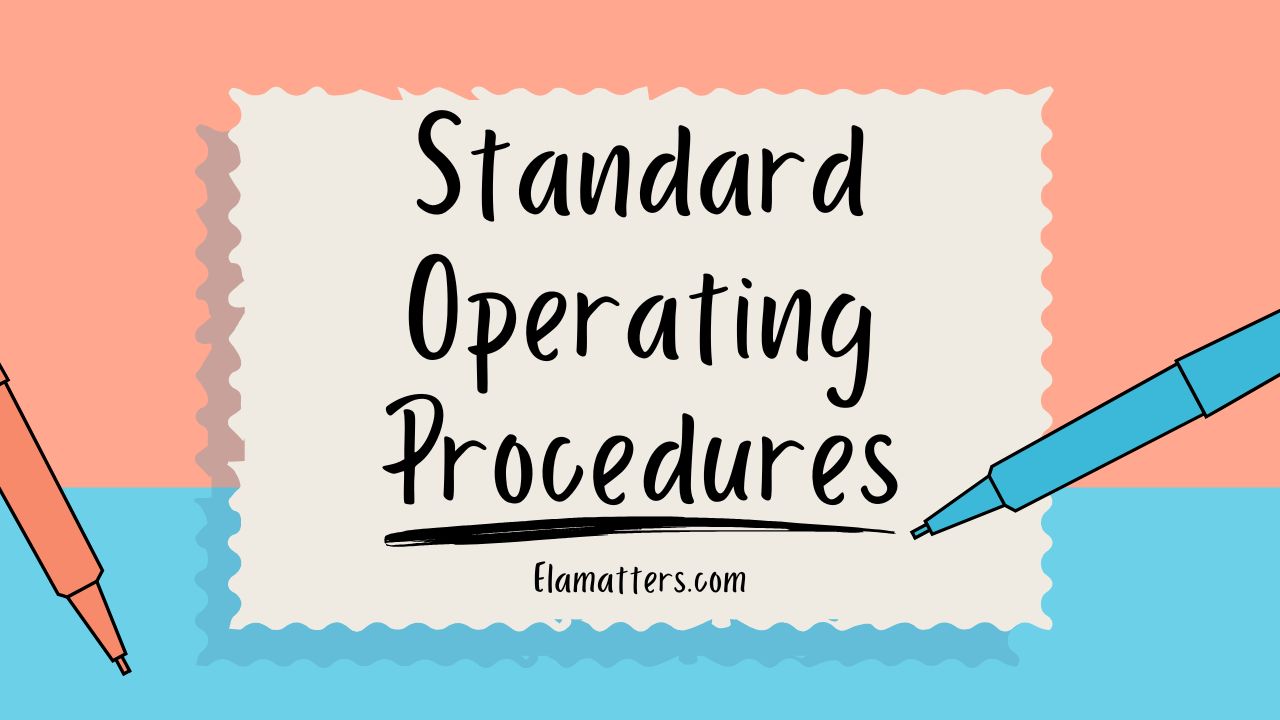In the fast-paced world of business, consistency and efficiency are key to success. That’s where Protocolo Operacional Padrão—or Standard Operating Procedures (SOPs)—come into play. These essential documents serve as a roadmap for your team, detailing how tasks should be performed to ensure quality and compliance. Whether you’re navigating complex processes or simply looking to streamline operations, SOPs provide clarity and structure.
Imagine having a reliable guide that helps onboard new employees quickly while also minimizing errors in daily tasks. With effective SOPs, businesses can foster collaboration and enhance productivity across all levels. So why wait? Let’s dive deeper into the transformative power of SOPs and discover how they can elevate your business operations to new heights.
Understanding Standard Operating Procedures (SOPs)
Standard Operating Procedures (SOPs) are detailed, written instructions designed to guide employees through specific tasks or processes. They serve as a baseline for consistency and efficiency in various business operations.
At their core, SOPs help eliminate ambiguity. When everyone follows the same set of guidelines, it reduces the chances of errors and enhances productivity. These procedures can cover anything from routine maintenance to customer service protocols.
Creating effective SOPs requires clarity and precision. Each step should be easy to follow, ensuring that team members understand exactly what is expected of them. By documenting these processes, businesses also create a valuable resource for training new staff.
Moreover, SOPs promote accountability within teams. With defined roles and responsibilities outlined in each document, individuals know who is responsible for what task—fostering ownership and commitment throughout the organization.
The Importance of SOPs in Business Operations
Standard Operating Procedures (SOPs) play a crucial role in business operations. They serve as clear guidelines that streamline processes, ensuring consistency across tasks. When everyone follows the same procedures, it minimizes errors and increases efficiency.
Moreover, SOPs enhance training for new employees. With documented steps available, onboarding becomes smoother and faster. This results in a more competent workforce prepared to tackle challenges head-on.
SOPs also foster accountability within teams. By defining roles and responsibilities, each member knows what is expected of them. This clarity helps reduce confusion and promotes teamwork.
Additionally, having established SOPs can improve compliance with industry regulations. Following standardized practices ensures that businesses meet necessary legal requirements while maintaining quality standards.
Regular reviews of these procedures encourage continuous improvement. As companies evolve, so should their processes to adapt to changing environments or technologies.
Creating an Effective SOP
Creating an effective SOP starts with identifying the process or task at hand. Clearly define what you want to achieve and why it matters. This clarity will set the stage for everything that follows.
Next, outline each step involved in the process. Use simple language to describe actions, avoiding jargon whenever possible. This ensures everyone can understand and follow along.
Establish clear objectives and goals tied directly to your business’s needs. When team members know what success looks like, they’re more likely to strive for it.
Define roles and responsibilities within your team. Everyone should understand their specific tasks as well as how they contribute to the broader picture.
Incorporate feedback from those who will use the SOP regularly. Revisions based on real-world insights improve functionality over time, making your procedures even more efficient.
A. Identifying the Process or Task
Identifying the process or task is the first crucial step in creating a Protocolo Operacional Padrão. It sets the stage for everything that follows. Clear identification helps ensure that everyone understands what needs to be accomplished.
Start by analyzing your current workflows. What tasks are repetitive? Are there any pain points that create confusion among team members? Engaging with staff can provide valuable insights into their daily routines and challenges.
Once you narrow down a specific process, document it thoroughly. Be sure to describe its purpose and relevance to your overall business goals. This clarity will guide your team through implementation later on.
Focusing on one task at a time prevents overwhelm and promotes efficiency during SOP development. Remember, this step lays the groundwork for consistency, quality control, and ultimately better performance across operations.
B. Outlining the Steps Involved
Outlining the steps involved in a process is crucial for creating a clear Protocolo Operacional Padrão. Each step should be easy to follow, ensuring that anyone can execute the task without confusion.
Begin by breaking down complex tasks into smaller, manageable actions. This makes it easier for team members to grasp what needs to be done at each stage.
Use simple language and avoid jargon when possible. The goal is clarity; you want your SOP to be accessible to everyone on the team, regardless of their background or experience level.
Visual aids can also enhance understanding. Flowcharts or diagrams can complement written instructions and provide an additional layer of guidance.
By carefully outlining these steps, you set a solid foundation for consistent execution and quality control within your organization.
C. Establishing Clear Objectives and Goals
Setting clear objectives and goals is crucial in the development of an effective Protocolo Operacional Padrão. These benchmarks guide the entire process, ensuring that everyone understands what needs to be achieved.
When establishing these goals, it’s essential to make them specific and measurable. Vague targets can lead to confusion and misalignment among team members. Instead, focus on defining precise outcomes that reflect your organization’s standards.
Consider involving team members in this stage; their insights can provide valuable perspectives. Engagement fosters ownership, making individuals more committed to achieving the established objectives.
Ensure that the goals are realistic yet challenging. This balance motivates employees without overwhelming them or setting them up for failure. A well-defined set of objectives not only clarifies expectations but also paves the way for continuous improvement within your SOP framework.
D. Defining Roles and Responsibilities of Team Members
Defining roles and responsibilities is essential for a successful Protocolo Operacional Padrão. Each team member must clearly understand their tasks to avoid confusion.
Start by identifying the expertise of your team. This ensures that the right person handles each aspect of the process. Assigning specific duties allows individuals to take ownership, fostering accountability.
Make use of visuals like charts or tables. These tools can help illustrate who is responsible for what at a glance. It enhances clarity and helps everyone stay aligned with their objectives.
Additionally, encourage open communication about these roles. Team members should feel comfortable discussing overlaps or gaps in responsibilities, which promotes collaboration and efficiency.
Regularly revisit role definitions as processes evolve or new projects arise. Keeping an adaptable mindset will ensure that everyone remains on track while contributing effectively to the overall goals of the organization.
E. Incorporating Feedback and Revisions
Incorporating feedback and revisions is crucial for the success of any Protocolo Operacional Padrão. It transforms a basic document into a living guide that evolves with your business needs.
Encourage team members to share their insights after using the SOP. They often notice gaps or inefficiencies that might not be evident during its creation. Their hands-on experience can provide valuable perspectives.
Set periodic reviews to assess its effectiveness. This ensures the SOP remains relevant as processes change over time.
Keep an open line of communication, fostering an environment where constructive criticism is welcomed. Emphasizing collaboration makes it easier to implement necessary adjustments smoothly.
Document all changes carefully so everyone stays on the same page regarding updates and revisions made along the way. This practice promotes accountability and clarity throughout your organization, ensuring consistency in operations while adapting to new challenges effortlessly.
Implementing and Maintaining SOPs
Implementing SOPs involves more than just drafting a document. It requires training your team to understand and embrace these protocols in their daily routines.
Start by introducing the SOP gradually. Offer workshops or training sessions that highlight its importance and practical applications. This helps foster a culture of compliance and accountability within the organization.
Maintaining SOPs is equally crucial. Regular reviews are necessary to ensure they remain relevant as processes evolve over time. Establish a schedule for revisiting each procedure, allowing room for updates based on feedback or changes in operations.
Encourage open communication among team members regarding any challenges faced while following the SOPs. This dialogue can lead to valuable insights that improve efficiency and effectiveness.
Empowering employees with ownership over these procedures promotes adherence, making it easier to integrate them into everyday practices seamlessly.
Common Mistakes to Avoid in SOP Creation
Creating an effective Protocolo Operacional Padrão (SOP) can significantly enhance your business operations. However, there are common pitfalls that can undermine the effectiveness of these procedures.
One mistake is failing to involve team members in the SOP creation process. When employees who will use the SOP feel excluded, they may not buy into it fully, resulting in low compliance. Ensuring that those on the ground provide input helps create a sense of ownership and responsibility.
Another issue is being too vague or overly complex in your documentation. Clarity is key when drafting an SOP. If steps are confusing or filled with jargon, users might struggle to follow them correctly. Aim for simplicity and directness; clear language leads to better execution.
Additionally, neglecting regular reviews and updates can render even well-crafted SOPs obsolete over time. Processes evolve; feedback should be integrated systematically to keep documents relevant and useful.
Overlooking training for new employees on existing SOPs can lead to inefficiencies down the line. It’s crucial that all staff understand how to access and implement these protocols effectively from their first day onward.
By steering clear of these mistakes, you’ll set a solid foundation for successful implementation of your Protocolo Operacional Padrão within your organization.

